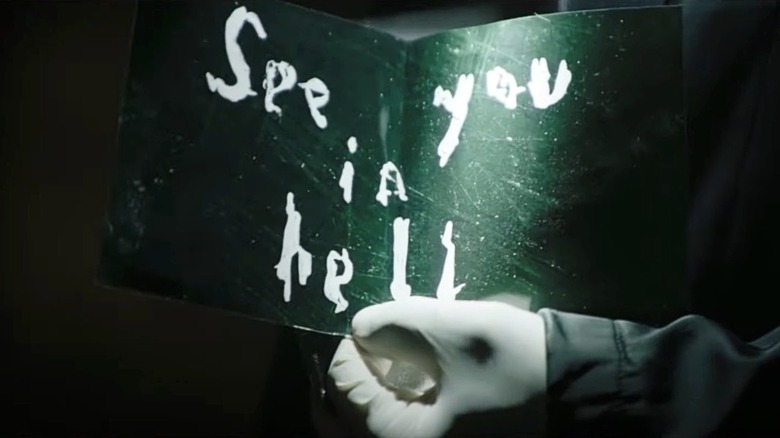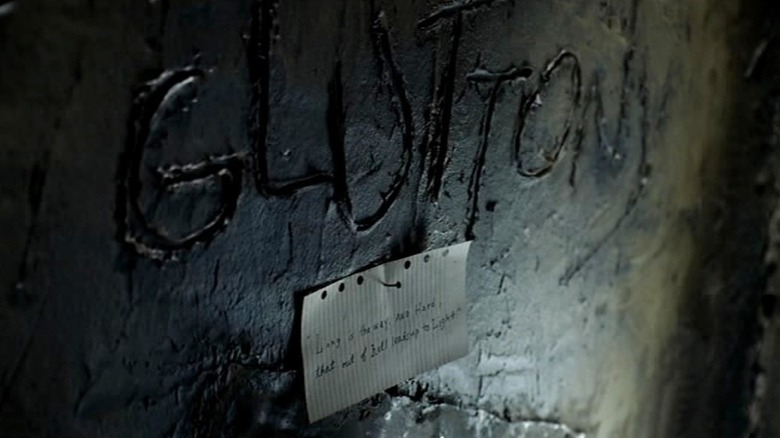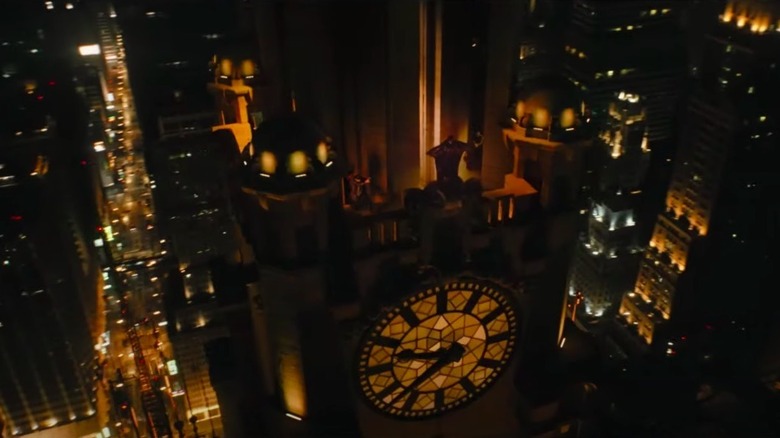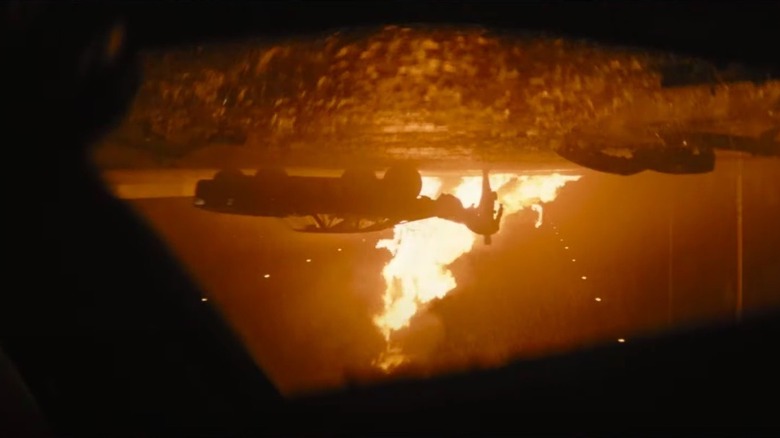The Visuals Of The Batman Trailer Owe A Lot To David Fincher's Se7en
DC FanDome is here, and with it announcements on a number of highly anticipated film, TV, comic, and other properties from the world of DC. Of all the projects teased at FanDome, Matt Reeves' upcoming movie "The Batman" is clearly one of the most exciting. And with the second trailer finally released, it's easy to see what all the excitement is about.
The trailer sees Batman (Robert Pattinson) contend with "The Riddler" (Paul Dano), a serial killer obsessed with proving himself Batman's intellectual superior. There are thematic similarities aplenty, but the stunning trailer also reveals a number of visual inspirations that aesthetically recall a classic David Fincher film in both setting and overall visual technique. Here's a breakdown of the ways "The Batman" trailer borrows visually from Fincher's "Se7en."
Theme
In "The Batman," The Riddler's crimes aren't random — they're personal, intended to draw out Batman specifically and to taunt him. The crime scenes are affixed with notes and messages as "clues" scrawled across the floors and walls, all hoping to involve Batman in this sick twisted game. Visually it creates an overall scene where the chaos of the crimes are punctuated by their overt direction towards the detective performing the investigations. Each crime scene's aggressively scrawled clues even tease "sins" to taunt the detective, each as part of a cat-and-mouse game to involve and triumph over them.
If that sounds a little like David Fincher's "Se7en," it should. We can already see that "The Batman" shares a number of additional thematic and plot elements with the 1995 thriller masterpiece. The trailer even sees our introduction to "The Riddler" off the bat (sorry, couldn't resist) being calmly arrested, undoubtedly as part of a plan to get closer to The World's Greatest Detective. It's visually reminiscent of both the police raid scene in "Se7en" and the scene where "John Doe" calmly, intentionally walks into the police station to further involve Brad Pitt's Detective Mills in his game. The introduction is also capped off with a Fincher-esque camera movement, smoothly pulling in and up to see the question mark in the coffee.
Setting
"Se7en" takes place in an unnamed fictional city, one that could stand in for any urban area with its abundance of rain-soaked concrete structures as far as the eye can see. While the visuals subtly change from crime scene to crime scene, the film as a whole shares the "color noir" style, showcasing the city as dark, bleak, neon-lit wasteland. The only thing saving us from the perpetual torrent of overcast and watery skies are the city's interiors, which are somehow even worse: cavernous crime scenes or shadowy concrete maws punctuated by artificial light.
From frame one in "The Batman" trailer we see Gotham as a series of menacing concrete structures soaked in rain (it's seriously always either raining or has just completed raining). The infinite darkness of the city is periodically interrupted by the neon chaos of what appears to be a criminal hideout, sharing with "Se7en" the visual alternation between moody torrential nightmares and bleak dens of villainy.
Visual Techniques
While there are substantial influences in theme and setting, the visual style itself bears a lot of resemblance to Fincher's masterpiece. As noted before, both "Se7en" and what we can see of "The Batman" so far show their cities as overcast dystopias where artificial light illuminates the rain and fog as the only thing punctuating the darkness. The interior landscapes aren't much brighter, with bleak darkened concrete structures and apartments being punctuated by the eye-straining artifice of man-made light. In both cases (and in classic noir fashion), all environments are drenched in unnatural man-made light that's constantly at war with shadow that threatens to swallow it whole.
Outside the similarities of light and color, we can also see so far that "The Batman" shares Fincher's penchant for slow, methodical camera movements and the disdain for handheld cinematography that Fincher is known for. The trailer's fight sequences eschew the Bourne-esque feverish quick cuts in favor of slow, steady movement (and even capturing the action still and from a distance). It also echoes Fincher's guiding visual principle, to use a cut in the service of furthering audience information, even evidenced in the trailer when the camera refuses to follow The Riddler's initial arrest and instead slowly crawls up and over to reveal the question mark in his coffee.
With two trailers now in the books, "The Batman" is shaping up to be a must-see film that really leans on strong visual storytelling drawing from the bleakest of modern neo-noirs.
"The Batman" releases in theaters on March 4, 2022.



